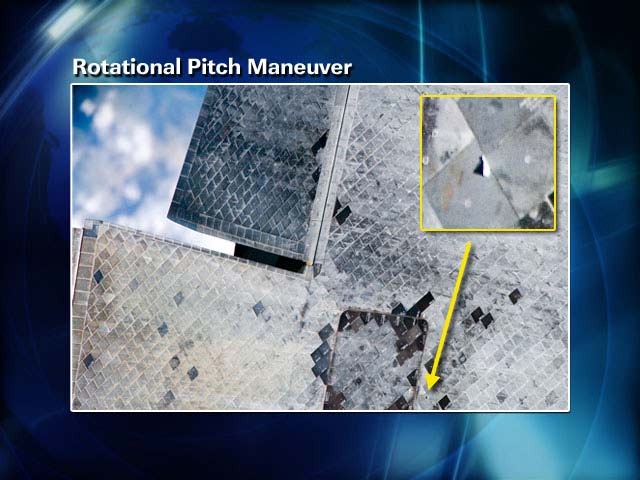Discovery Shuttle's Heat Shield Looks Good, NASA Says

HOUSTON - The space shuttle Discovery'sheat shield, so vital to returning its STS-121 astronaut crew home to Earth,appears to be in fine shape based on early image analysis, mission managerssaid Thursday.
"Overall, areally clean vehicle," said NASA's John Shannon, deputy shuttle programmanager, of Discovery during a mission briefing here at Johnson Space Center(JSC). "We were looking for things to talk about at one point, it is so clean."
Discovery'sheat shield could be given a clean bill of health by the end of the weekend, Shannon said.
Shannon's comments came after an initial analysisof some of the 352 high-resolution images of Discovery's heat shield taken earliertoday by astronauts aboard the International Space Station (ISS) during the shuttle'smorning docking. A further review is pending, but analysts have identifiedonly a few targets for possible follow-up inspections on Friday by the STS-121crew.
Among themare:
- An area along Discovery's nose cap that appears to have been missed during an earlier laser instrument scan on Wednesday. Analysts are studying the high-fidelity images taken of the orbiter by Expedition 13 astronauts Pavel Vinogradov and Jeffrey Williams to determine whether they fill in the needed gaps.
- A newly-found gap filler jutting from between two tiles well aft on Discovery's belly, just ahead of an umbilical door where a strut connected the orbiter to its external tank. "It's really cockeyed," Shannon said. "It almost came out, but not quite."
- A piece of fabric-like material poking out just behind the shuttle's nose cap that does not appear to be a gap filler, but merits extra interest.
- And the previously known gap filler discovered Wednesday by the STS-121 crew during orbital boom inspections of Discovery's port wing leading edge.
Heat shieldimagery analysts were expected to convene at 7:00 p.m. EDT (2300 GMT) to decideexactly which items merit time during a four-hour block on Friday reserved foradditional boom inspections by primary shuttle robotics operators Lisa Nowakand Stephanie Wilson.
"I wouldsay we'd probably use all of that four hours," Shannon said of the follow-upinspections, adding that the estimate allows for the time needed to slowly movethe orbital boom from Discovery's nose cap region to the aft gap fillers.
Get the Space.com Newsletter
Breaking space news, the latest updates on rocket launches, skywatching events and more!
Shannon added that additional study haspinned down the area of the sheet of foam that peeled free in pieces fromDiscovery's fuel tank during launch. Early estimates set the area at about thesize of an 8.5 by 11-inch (21 by 27-centimeter) sheet of paper, but the actualsize was a bit larger at 12.3 inches by 14.2 inches (31 by 36 centimeters),with a thickness of up to one inch (2.5 centimeters), Shannon said.
"Theinitial report from the external tank project was that we did not violate anyconditions that we set pre-flight," Shannon said.
The sevenDiscovery astronauts are NASA's second shuttle crew to fly to the ISS since the2003 Columbia accident.They have ferried European Space Agency (ESA) astronaut Thomas Reiterto join the Expedition 13 crew, and will deliver some of their 3.6 tons ofcargo to the station on Friday.
Inspectionboom of the future
Shannon said discussions are underway onthe future of Discovery's orbital inspection boom, which adds 50 feet (15meters) to the shuttle's already 50-foot robotic arm. The boom carriessensitive visual and laser cameras, as well as a laser radar, to scan anorbiter's heat shield.
During NASA'sSTS-118 mission - currently slated to launch in mid-2007 - shuttle officials planto launch a set of brackets for the ISS to accommodate the boom so a newer,smaller version could be developed.
"Thethought is that we would like to have a smaller, better boom that's a littlebit easier to use with better sensors to fly up on the space shuttle," Shannon said. "You want that nice long boom from a reach standpoint but from an inspectionstandpoint you'd like a little smaller boom."
The currentboom gives access to much of an orbiter's surface, and will be tested for itspotential as a work platform by STS-121 spacewalkers Piers Sellers and MichaelFossum on Saturday. But the boom does weigh about 800 pounds (362 kilograms),which takes a hefty bite out of a shuttle's cargo lift capability, NASA said.
"We'd likesomething a little less so we can carry up more cargo," Shannon said.
The currentshuttle inspection boom could be installed at the ISS about five shuttleflights in the future, he added.
- Gallery: Shuttle's First Flight
- Gallery: Rare Space Shuttle Images
- Shuttle Discovery: Complete Mission Coverage
- Great Space Quizzes: Space Shuttle Countdown
- Great Space Quizzes: The Space Shuttle
- Great Space Quizzes: Life in Orbit
Join our Space Forums to keep talking space on the latest missions, night sky and more! And if you have a news tip, correction or comment, let us know at: community@space.com.

Tariq is the Editor-in-Chief of Space.com and joined the team in 2001, first as an intern and staff writer, and later as an editor. He covers human spaceflight, exploration and space science, as well as skywatching and entertainment. He became Space.com's Managing Editor in 2009 and Editor-in-Chief in 2019. Before joining Space.com, Tariq was a staff reporter for The Los Angeles Times covering education and city beats in La Habra, Fullerton and Huntington Beach. In October 2022, Tariq received the Harry Kolcum Award for excellence in space reporting from the National Space Club Florida Committee. He is also an Eagle Scout (yes, he has the Space Exploration merit badge) and went to Space Camp four times as a kid and a fifth time as an adult. He has journalism degrees from the University of Southern California and New York University. You can find Tariq at Space.com and as the co-host to the This Week In Space podcast with space historian Rod Pyle on the TWiT network. To see his latest project, you can follow Tariq on Twitter @tariqjmalik.










